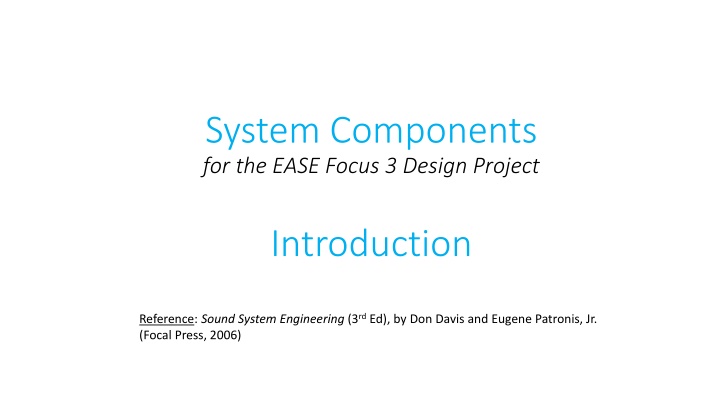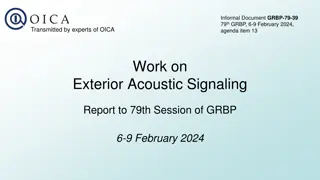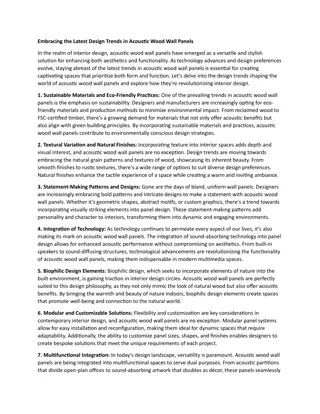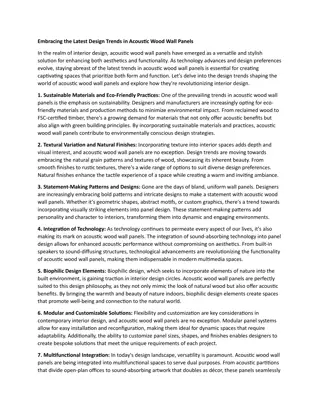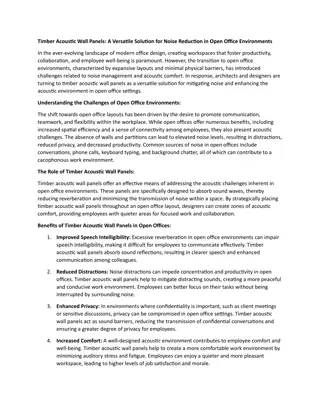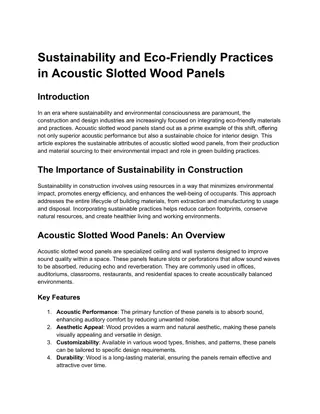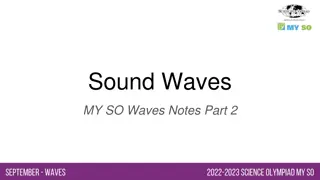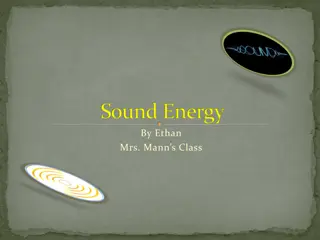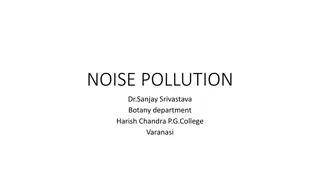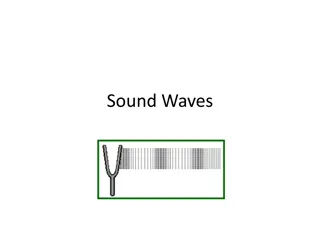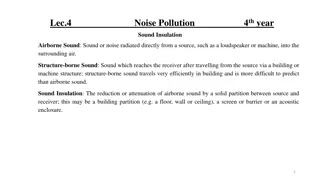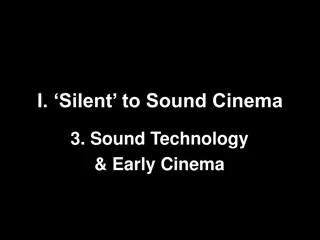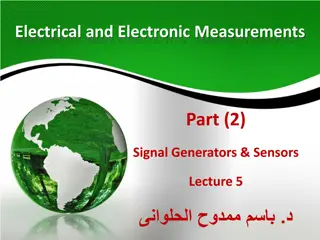Acoustic Environment: Sound Paths and Reflections
Examine the complexities of the acoustic environment indoors, focusing on direct, early reflections, and reverberant sounds in multi-purpose venues. Understand the impact of room geometry, surface treatments, and temperature gradients on sound quality and intelligibility. Dive into the factors influencing room reverberation and how to determine reverberation time effectively.
Download Presentation

Please find below an Image/Link to download the presentation.
The content on the website is provided AS IS for your information and personal use only. It may not be sold, licensed, or shared on other websites without obtaining consent from the author.If you encounter any issues during the download, it is possible that the publisher has removed the file from their server.
You are allowed to download the files provided on this website for personal or commercial use, subject to the condition that they are used lawfully. All files are the property of their respective owners.
The content on the website is provided AS IS for your information and personal use only. It may not be sold, licensed, or shared on other websites without obtaining consent from the author.
E N D
Presentation Transcript
System Components for the EASE Focus 3 Design Project Introduction Reference: Sound System Engineering (3rd Ed), by Don Davis and Eugene Patronis, Jr. (Focal Press, 2006)
Outline Good Sound: Context and Complications Acoustic Environment Indoors Intelligibility Designing for Acoustic Gain Good Sound: Quality Factors and Overall Goals
Good Sound: Context and Complications EASE Focus 3 Project: multi-purpose venue, fixed installation Context: large coverage area plus balcony multiple arrays and delay zones high power/SPL Complications: room geometry and surface treatments may exacerbate unwanted reflections and excessive reverb intelligibility issues temperature gradient more stable (than outdoors), but may shift seasonally (summer vs. winter) delay compensation overlap areas in array coverage causes comb filtering effects necessitating tight array directivity control and careful aiming variable audience fill effects, seat characteristics
Acoustic Environment Indoors The sound arriving at a listener s ears has (at least) three distinct divisions: direct sound early reflections reverberant sound The direct sound undergoes no reflections and follows inverse- square-law level change (-6 dB per doubling of distance) The reverberant sound tends to remain at a constant level if the sound source continues to put energy into the room at a regular rate
Acoustic Environment Indoors Sound paths in a concert hall Time relationship of direct and reflected sounds Comparison of direct, early, and reverberant sound fields in an auditorium
Acoustic Environment Indoors Consider enclosed space with internal volume V and total boundary surface S Each surface si has an absorption coefficient ai The average absorption coefficient is aavg = [ si ai] / S The room constant R = (S aavg)/(1-aavg) The room will possess a reverberation time RT60 (time in seconds for steady-state sound to attenuate 60 dB) Determination of RT60
Acoustic Environment Indoors This gives rise to several basic sound fields: near field free field reverberant field The near field is typically defined to be within a distance of twice the largest dimension of the sound source In the (far) free field, inverse-square-law level change prevails In the reverberant (diffuse) field, sound energy density is nearly uniform Critical distance (Dc) far field Sound fields in an enclosed space
Acoustic Environment Indoors Dc (the critical distance ) is the point at which the direct sound and the reverberant sound are both at the same level Dc determines the maximum acoustical separation, hence maximum acoustic gain Dc can be controlled by changing R (the absorption of the room surfaces) or the Q of the loudspeaker (higher Q, more directive, less reverberant energy) Dc determines the required directivity of the loudspeaker in an existing room Critical distance (Dc) Sound fields in an enclosed space
Intelligibility Several methods have been devised for assessing the speech intelligibility of sound reinforcement systems Articulation loss of consonants (%ALCONS) is one method of determining the articulation score of an enclosed space If ALCONS < 10%, intelligibility is very good Between 10-15%, intelligibility is sufficient ALCONS of 15% is considered a practical working limit Can use EASE to calculate an ALCONS map of your venue (not available in EASE Focus 3)
ALCONS Definition #1 A scale of the percentage of the articulation loss of consonants. A formula derived by V.M.A. Peutz based on distance, RT60, Volume of air in the room, the N factor, and the Q of the source. A measure of how difficult it is to understand someone in a room. The lower the number, the better for speech intelligibility. Source: Church Audio & Acoustics Glossary
ALCONS Definition #2 The measured percentage of Articulation Loss of Consonants by a listener. An ALCONS of 0% indicates perfect clarity and intelligibility with no loss of consonant understanding, while 10% and beyond is growing toward bad intelligibility, and 15% typically is the maximum loss acceptable. Source: http://www.owenscorning.com/around/sound/glossary.asp
Causes of Reduced Intelligibility Poor signal-to-noise ratio (SNR or S/N) Excessive reverberation Long/delayed reflections, echoes Loudspeaker misalignment Poor equalization Q too low (main array beamwidth too wide) Excessive distance from source
Designing for Acoustic Gain Sound (at listener s ears) must be sufficiently loud (25 dB above ambient noise level at mid-frequencies in rooms with RT60 1.6 sec) Sound must reasonably approximate audio spectrum produced by source Sound must reasonably approximate a ratio of direct-to- reverberant sound within the constraints of acceptable articulation loss
Good Sound: Quality Factors frequency range/response, smoothness SPL at (furthest) listening position headroom ( Crest factor ) evenness of coverage (spectral and spatial stability) intelligibility (articulation loss of consonants) ratio of direct sound field to reverberant sound field gain before feedback noise (SNR) and distortion (IM and THD) transient response and damping factor group delay (frequency-dependent arrival times) locality of reference
Good Sound: Overall Goals minimum spectral variance over space minimum level variance over space minimum ripple variance over space maximum power addition over space
System Component Selection Loudspeakers Power amplifiers Signal processors Mixing consoles Microphones Hearing assistive devices Racks, cabling, and wiring
